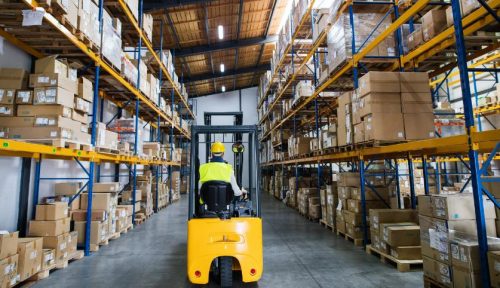A business’s long-term success depends on various factors, such as its operations’ efficiency and safety. But despite standard operating procedures, technologies, and laws, material handling-related accidents may still happen in workplaces.
With that, businesses, especially manufacturing companies, must ensure the safety and efficiency of material handling for many good reasons. Some benefits include reducing safety risks, optimizing tool and equipment use, and boosting productivity. But how do businesses ensure that they’re doing material handling right?
Learn all about material handling safety and efficiency in this guide to help ensure successful overall operations.
What Is Material Handling?
 Essentially, materials handling pertains to a type of logistics activity involving the movement of raw materials and goods between conveyors, vehicles, store rooms, lifting equipment, and other logistics support elements where human workers have some degree of involvement.
Essentially, materials handling pertains to a type of logistics activity involving the movement of raw materials and goods between conveyors, vehicles, store rooms, lifting equipment, and other logistics support elements where human workers have some degree of involvement.
Guide To Material Handling Efficiency
The principle behind material handling efficiency is approaching a steady and straight material flow with continuous movements and the least interpretations and backtracking possible.
With that, businesses must have a standard material handling principle. All procedures, controls, tools, and equipment must be standardised to optimize performance while considering their limitations. But it shouldn’t compromise versatility, output, and transportability.
Here are some expert recommendations to promote safe material handling:
Research And Invest In Appropriate Material Containers
The most commonly used containers for materials include paper bags and paper boxes. However, paper isn’t an ideal option if the material involved is a wet solid, liquid, slurry, or any moist product. Even reinforced paper products sprayed or filled with a liner will soak and deteriorate.
 Instead of using cheap paper bags, consider using more durable containers. For instance, a flexible intermediate bulk container (FIBC), FIBC bags, or bulk bags are custom-made to suit every business’s material handling specification.
Instead of using cheap paper bags, consider using more durable containers. For instance, a flexible intermediate bulk container (FIBC), FIBC bags, or bulk bags are custom-made to suit every business’s material handling specification.
In addition, FIBC bags can also replace plastic-carrying containers. Hand-carry plastic totes are ideal for carrying many small objects. However, using FIBC bags can streamline the entire process by allowing faster and more efficient loading and moving of materials. And because FIBC bags come in different shapes, sizes, and configurations, they can also help enhance shipping containers, hoppers, and liquid loaders.
Invest In Appropriate Material Handling Equipment
Investing in the appropriate material handling equipment can help boost efficiency, lifting and moving materials quicker and safer than manual handling. This is especially since manual material handling can be time-consuming and comes with high safety risks, and can be prone to human error.
For instance, warehouses and factories should have conveyor belt systems that handle different material sizes and weight capacities. They may also need automated and bulk equipment for moving materials, such as silos, grain elevators, drums, and trucks. In addition to FIBC containers, investing in storage equipment such as racks, pallets, and shelves is also a must-have for more efficient and systematic material handling.
Guide To Material Handling Safety
As a starting point for safe material handling, it’s crucial to follow certain guidelines to avoid health problems and related accidents, like tripping, falling, and slipping.
The most common safety hazards that involve material handling include overloading of listing devices, repetitive and heavy manual lifting, and moving equipment collisions. Storage problems could also arise due to improper material handling, such as damaged storage units and the falling of improperly stored materials.
 Because workers handle different sizes, weights, and quantities of materials in the workplace every day, it’s paramount for every business, even for small business to have a material handling safety policy. A custom-tailored safety policy can help health and safety of workers who directly handle materials in the workplace.
Because workers handle different sizes, weights, and quantities of materials in the workplace every day, it’s paramount for every business, even for small business to have a material handling safety policy. A custom-tailored safety policy can help health and safety of workers who directly handle materials in the workplace.
With that, here are some expert recommendations to promote safe material handling:
Conduct Regular Material Handling Safety Training
Generally, workers face different safety hazards in warehouses, shop floors, loading docks, and distribution centres. Therefore, training should be conducted regularly to increase awareness, knowledge, and skills on how to handle materials in the safest way possible.
To start, new employees should undergo safety training to increase safety in your business. In that way, they’ll learn how to lift, carry, load, and transport any type of material. And aside from new hire safety training, additional training is necessary for all employees to ensure compliance and reinforce safety rules. Hence, annual safety re-training is highly advisable.
Enforce Rules On Safety Gear And Personal Protective Equipment
Workers must wear the appropriate safety gear or protective equipment to prevent injuries when moving or handling materials manually. And depending on the material they handle, they must wear eye protection, gloves, helmets, face shields, and safety boots.
 The management should see to it that everyone in the organization abides by such protocols to ensure a safe and efficient workplace. Aside from cascading safety guidelines and regulations during meetings and regular training, imposing penalties can also help reinforce the importance of wearing safety gear and protective equipment during operating hours.
The management should see to it that everyone in the organization abides by such protocols to ensure a safe and efficient workplace. Aside from cascading safety guidelines and regulations during meetings and regular training, imposing penalties can also help reinforce the importance of wearing safety gear and protective equipment during operating hours.
Follow Material Handling Safety Procedures
Employees must know and follow the safety procedures indicated in their safety training modules and manuals to avoid accidents. Consistently following safety procedures can go a long way in safeguarding workers’ overall health and well-being.
For instance, as much as possible, workers must be keen on observing the work area for any obstacles, such as poor lighting conditions, wet floors, and other safety hazards, for proper reporting. Aside from that, employees should also observe proper posture when lifting or transferring materials since improper lifting can cause muscle strain, back injury, and other musculoskeletal health problems.
Review Safety Policy
Another key to ensuring a safe and efficient process when handling materials is an updated policy. It’d be good to note that changes may occur along the way, and to help ensure the safety of workers, reviewing policies and guidelines from time to time can be helpful. Moreover, by doing so, you can be assured that your business remains compliant with local regulations.
 Hiring occupational health experts is a great way to help a business assess its safety policy. These professionals can make expert recommendations on how employees must handle new materials and the appropriate equipment for safe and efficient operations.
Hiring occupational health experts is a great way to help a business assess its safety policy. These professionals can make expert recommendations on how employees must handle new materials and the appropriate equipment for safe and efficient operations.
Final Thoughts
It’s crucial for businesses to develop, implement, and reinforce customised material handling policies for safety and efficiency. To start, they must invest in the right protective equipment, lifting equipment, storage, and material handling tech solutions to improve workflow and avoid accidents. Furthermore, employees must wear safety gear, undergo proper training, and follow safe material handling procedures specified in their training manual.



































